I’ve watched people come into Wheel Pose for many years and it can be one of the hardest poses for people to do.  Why? I think of it this way: it’s the furthest movement away from where we spend most of our time, posturally. What do I mean by that? Well, most of the time, we’re hunched over our computers, sitting. In that position, our hips are flexed and our shoulders are internally rotated. We’re there a LOT. And then, for exercise, we do things like run and bike. And THEN, we go to yoga, maybe a few times a week and someone suggests that we 1- fight gravity 2- extend our hips  and 3- externally rotate our shoulders when just about everything else we are doing involves internally rotating our shoulders and flexing our hips.
One of the things we need to keep in mind when we practice is that nothing happens in a vacuum. We know this of course, but sometimes in our efforts to “come into a pose” our minds and our bodies are working at a bit of a disconnect. We may want to get into that pose and know how to get into that pose but given what we’ve been doing to prepare, we may not be ready to admit that it’s going to be pretty challenging if not impossible without injury to do it. I can “want” to do a full split until I’m blue in the face but unless I take baby steps and consistently lengthen my hamstrings and other muscle groups, I will never be able to do it. Honestly, it really doesn’t matter all that much to me and I’ve given up trying to get into certain poses that are deemed “hard, challenging and Instagram worthy” despite encouragement to do so because somehow that demonstrates my “expert” status as a yoga teacher and will get me lots of new followers. ( Ok, I’m veering off track here so let me get back on topic).
So, here’s quick bit about the anatomy of Wheel Pose as it relates to the upper body. When we prepare to come into Wheel, we need to 1- flex our shoulders 2- bend our arms 3- flatten our palms to the mat and 4- externally rotate our shoulders. When you think about those actions, generally, the flexion of the shoulders is do-able for many (as you sit there right now, reach your arms up to the sky and see how much range you have). Elbow flexion is also not too much of an issue for most either. However, the last two actions: flattening the palms and externally rotating the shoulders can be quite difficult for many of us. Wrist tightness and tenderness is common. The positions we hold when typing can cause issues with the flexors and extensors of the wrists, along with our constant position holding our phones and typing/texting. Further, many students use the hands to PUSH UP into the pose rather than having the power come from the legs. I often tell my students, “Think of the legs as the power to push UP and the hands as the steering wheel.”
Lastly, the external rotation needed from the shoulders, along with a “wrapping” of the shoulders blades (versus an elevation or “hunching” sensation) is needed but challenged because of all the postural and athletic activities we may be doing (see above). So, where does this leave us?
First let me say that I explain this in detail because I believe that in order for students to “get it” (whatever that is) they need to “understand” it on an academic level. From there, they can apply the knowledge to the movements required to move into any posture. So, we discussed the actions needed for Wheel:
Shoulder Flexion, as seen here in Downward Dog:
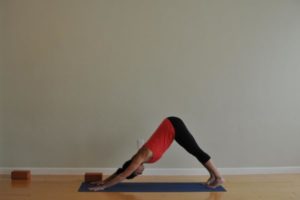
External Rotation as seen here in Mountain Pose:

Wrapping of the shoulder blades, as seen here in Eagle Pose:
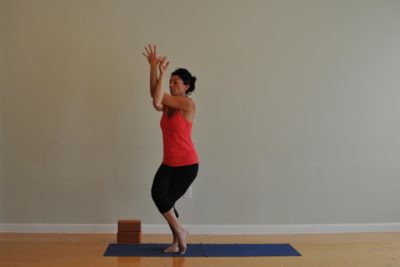
So, let’s quickly review some of the muscles involved in these actions:
Shoulder flexion: Anterior Deltoid
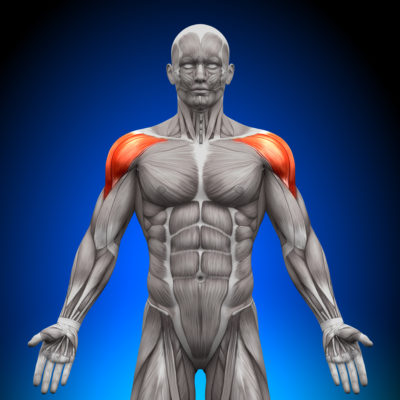
Shoulder external rotation: Teres Minor
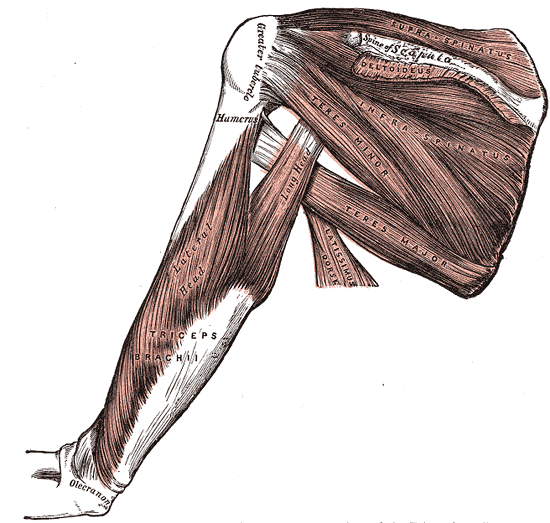
Shoulder stabilization: Serratus Anterior
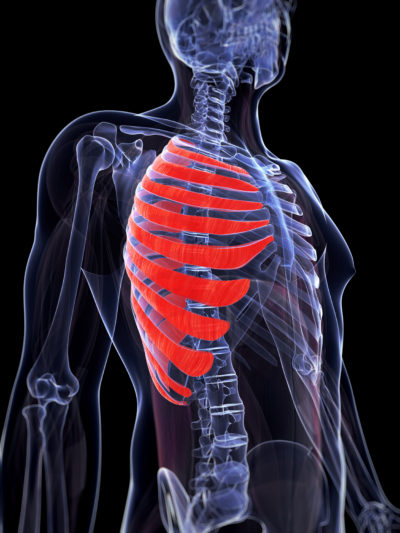
Now, the muscles I refer to above are ACTION muscles, meaning these muscles have to do their job in order to create the movement to come into this pose. One of the muscles though that can usually be pretty tight in people from all the habits I discussed earlier are the pectoral (chest) muscles (major and minor- internal rotators). So, these muscles need some length versus contraction.
So, poses to help strengthen the Serratus: Plank, Downward Dog, Eagle, Dolphin
Poses to help strengthen the Deltoid: Warrior 1 and 2, Downward Dog
Poses to help strengthen external rotators: Bow, Locust, any pose variation where fingers are interlaced behind the back
Poses to help lengthen internal rotators/pectoral muscles of chest: Upward Dog, Camel, Side Angle and variations, Dancer’s Pose, Airplane, Locust and Bow.
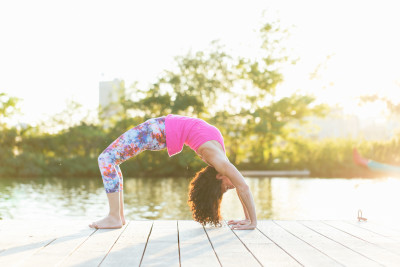
I hope you’ve enjoyed this outline and overview of the anatomy and actions related to Wheel Pose.
If you like the study of anatomy you may want to download my 3 anatomy worksheets by clicking the button below.
Interested in receiving a 3-PDF Teacher’s Yoga Anatomy Kit? Click here!

This post on the Wheel pose is absolutely amazing! I ‘ve been struggling with that pose for a long time. I did have rotator cuff surgery on both sides & I hunched over the guitar for over 30 years, so I will definitely incorporate the poses you suggested on preperation for the pose! Thank you so much for this post! Namaste
Brian, wonderful! I’m so glad to see that the post was helpful! Did you see the video on my Facebook page? It’s a recap in person of the blog post. Yes, the guitar.. I’ll bet that has made an impact and yoga is so great for you in terms of strengthening some of those muscles that get tight from hunching over the guitar. Thanks so much for letting me know. Have fun with your yoga! Karen